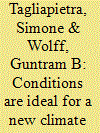| Srl | Item |
| 1 |
ID:
181470


|
|
|
|
|
| Summary/Abstract |
Annual global greenhouse-gas emissions have been rising steadily for decades and show no sign of peaking. That is, humankind is not making enough progress to exclude a possibly catastrophic climate scenario. Protecting the climate is difficult because of free-riding: emissions abatement costs are largely national but the benefits from climate stability are global. Dealing with this problem needs to be at the core of a new climate strategy. This article argues that both technological and political conditions are now ideal to establish a new climate club, in which members commit to stronger domestic climate measures and agree on the coordinated introduction of carbon border adjustment measures. On the technology side, there have been stunning clean technology cost reductions. This will underpin the climate club: as abatement costs fall, club stability can be more easily achieved. On the political side, we now see the United States, European Union and China – representing half of global greenhouse gas emissions – sharing for the first time a common climate ambition while popular support in all economies is also high for substantial climate actions. These two changes make a climate club more likely stable as the benefits from deviating from the club have diminished. A relatively weak penalty, such as carbon border adjustment measure, may then suffice for club stability. This climate club would also create incentive for other countries to join the club, thus making it a catalyst for tougher climate action worldwide.
|
|
|
|
|
|
|
|
|
|
|
|
|
|
|
|
| 2 |
ID:
117704


|
|
|
|
|
| Publication |
2012.
|
| Summary/Abstract |
The current European crisis has shed light on several weaknesses and the institutional incompleteness characterizing the euro area. The manifestation of Europe's fragility was preceded by a large build-up of debt in the private sector, associated with national current account divergences and the deterioration of competitiveness particularly of the euro periphery countries. With the economic situation deteriorating, private sector debt became less credible, contaminating banks' balance sheets and placing a heavy burden on governments. A sovereign-bank vicious circle emerged: on the one hand, with banking risk translating into higher sovereign risk because of the governments' guarantor role and, on the other hand, with the deterioration of government's creditworthiness affecting the banking systems through banks' sovereign bond holdings. In principle, this negative feedback can be stopped by breaking one of the channels of transmission. A banking union at the European level is proposed as one solution.
|
|
|
|
|
|
|
|
|
|
|
|
|
|
|
|